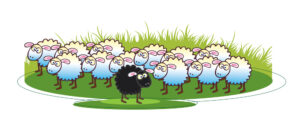
The two previous Words of Wisdom dealt with story lengths shorter than the novel: the short story and the novella. Today’s post, though not a Words of Wisdom one, will continue with a look at the “black sheep” of the short form, the novelette. While the novelette is recognized in various science fiction awards as a discrete length, this is not true for mystery and thriller, hence the “black sheep” in this post’s title.
Length-wise, short stories are usually defined as running from 2000-7500 words, while the novella is often defined as running from 20,000-40,000 words in length. Short stories are the typical length in many online magazines, and in story anthologies. Story anthologies can include longer lengths, of course, ranging into the novella length. But, in general, there’s a divide between the two forms.
The novelette lives in that divide, running between 7500 words and 20,000.
Masterclass discusses what distinguishes a novelette from a novella:
In terms of storytelling ambition, novelettes tend to split the difference between novellas and shorter forms like short stories. Novelettes tend to have a greater focus on character development, worldbuilding, and plotting than short stories. However, the stories are generally more concise and focused than a novella-length work, as the word count is often too restrictive to tell a long story. [The full post can be found here.]
Our very own James Scott Bell has written a number of novelettes, including the Force of Habit series and Trouble is My Business, each six novelettes long. In his March 3, 2013 KZB post, Jim touches on the novelette and its value in helping you train as a writer:
Training: A novelette is short form (about 15k words) and I’ve been studying that form as the e-book revolution has taken off. All writers now should be producing short form work in addition to full length novels. He goes on to discuss other aspects of his novelette—the post is well worth reading in it’s entirety.
In the Science Fiction field a novelette is defined as running from 7500 to 17,500 words.
The late science fiction grand master James Gunn felt that the novelette was the perfect length for science fiction: long enough to allow the writer to fully explore an idea but not so long as to become caught up in a plot that might be so complex and lengthy as to overshadow the exploration of that idea:
“Although there are some great SF novels, there are far more great SF novelettes, which embody the substance of a novel without taking on its burden to solve the problem it lays out.”
I had the opportunity to talk with Jim Gunn about this when I was at the University of Kansas for a two-week novel writing workshop in 2013. As a long time anthologist, editor and writer he was passionate that this was the case.
I feel the same might be true for mystery, especially the locked room variety. The novelette length is long enough to delve into a clever mystery and explore it without having to go to even the extent of plotting and number of characters a novella does. At the same time, there’s more room for characterization and world building then in a true short story.
In mystery or thriller, neither the novelette or the novella are mentioned in awards categories. The Edgar Awards short story category covers stories that run from 1,000 to 22,000 words. The International Thriller Writer Awards simply says that to be considered a short story it must be less than 35,000 words.
***
Alfred Hitchcock’s suspense film, The Birds, is based on Daphne Du Maurier’s 1952 novelette of the same name. In the novelette, the story is centered on Nat Hocken, a disabled WW2 veteran who works for a local farmer. Set on the windswept Cornish coast during a bleak autumn, Nat soon finds evidence of birds acting strangely, pecking at his bedroom window, and when he opens it, attacking him. At the same time, the autumn has turned a bitter, dry cold. Soon Nat notices gargantuan flocks of gulls riding the waves at sea, seemingly biding their time. What follows is a building horror as Nat realizes his family, and his community is under threat, and he takes steps to warn others and protect his family.
The POV is kept on Nat, and the focus on coordinated actions of the birds. The novelette takes place over three days. Radio broadcasts let Nat and the reader both know that the bird attacks are widespread, throughout the U.K., and perhaps the world, but we stay with Nat the whole time. The arc of the novelette is in Nat and his family’s evolving situation, as he becomes aware of the threat, and attempts to save his family and warn others.
I’ve published three novelettes, “Siloed,” which appeared in the Street Spells urban fantasy anthology, “Running Tangent,” co-written with K.C. Ball, which was published in the July 2015 issue of Perihelion Science Fiction, and the cozy mystery novelette, “Farewell, My Cookie,” which I published on BookFunnel last August. All three were in the range of 10-11,000 words. Both “Siloed” and “Farewell, My Cookie,” take place over the course of a single evening, while “Running Tangent” occurs over a longer span of time. I find novelette length ideal for briskly paced stories that took place over just a few hours.
For me, the novelette’s allowing more space for characterization, exploring an idea or a world and more room for plot than a short story while being more concise than a novella makes it a form worth considering.
How about you?
- Have you read novelettes? If so, do you have any favorites?
- Have you written novelettes?
- Do you think the novelette length worth writing for mystery, especially locked room or puzzle stories?




